What is effective altruism?
Effective altruism is a project that aims to find the best ways to help others, and put them into practice.
It’s both a research field, which aims to identify the world’s most pressing problems and the best solutions to them, and a practical community that aims to use those findings to do good.
This project matters because, while many attempts to do good fail, some are enormously effective. For instance, some charities help 100 or even 1,000 times as many people as others, when given the same amount of resources.
This means that by thinking carefully about the best ways to help, we can do far more to tackle the world’s biggest problems.
Effective altruism was formalized by scholars at Oxford University, but has now spread around the world, and is being applied by tens of thousands of people in more than 70 countries.1
People inspired by effective altruism have worked on projects that range from funding the distribution of 200 million malaria nets, to academic research on the future of AI, to campaigning for policies to prevent the next pandemic.
They’re not united by any particular solution to the world’s problems, but by a way of thinking. They try to find unusually good ways of helping, such that a given amount of effort goes an unusually long way. Here are some examples of what they've done so far, followed by the values that unite them:
What are some examples of effective altruism in practice?
Preventing the next pandemic
Why this issue?
People in effective altruism typically try to identify issues that are big in scale, tractable, and unfairly neglected.2 The aim is to find the biggest gaps in current efforts, in order to find where an additional person can have the greatest impact. One issue that seems to match those criteria is preventing pandemics.
Researchers in effective altruism argued as early as 2014 that, given the history of near-misses, there was a good chance that a large pandemic would happen in our lifetimes.
But preparing for the next pandemic was, and remains, hugely underfunded compared to other global issues. For instance, the US invests around $8bn per year preventing pandemics, compared to around $280bn per year spent on counterterrorism over the last decade.3
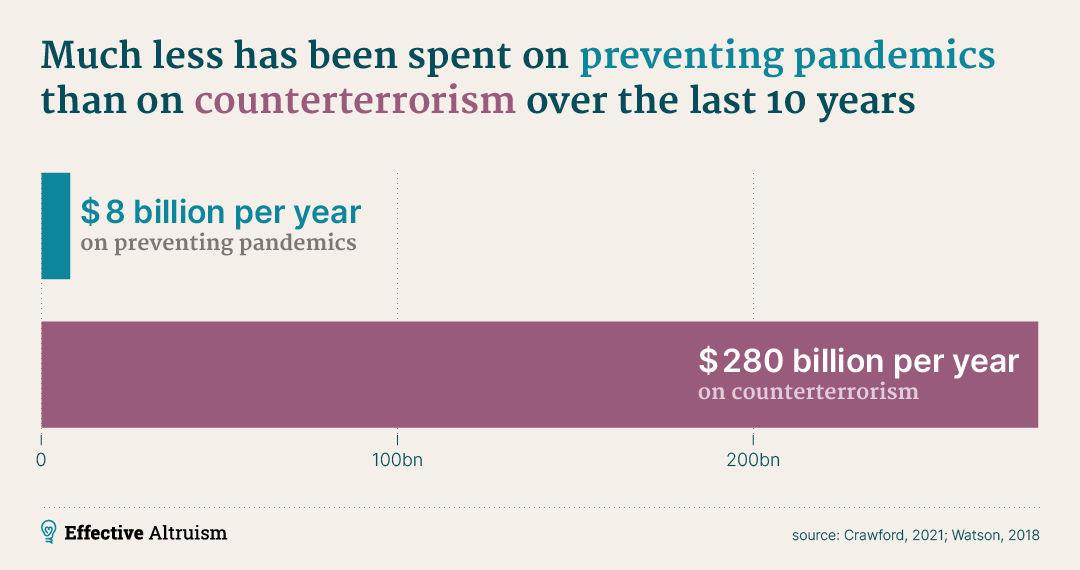
Preventing terror attacks is certainly important. But the scale of the issue seems smaller. For instance, just to focus on the number of deaths, in the last 50 years, around 500,000 people have been killed by terrorism. But over 21 million people were killed by COVID-19 alone4 – or consider the 40 million killed by HIV/AIDS.5
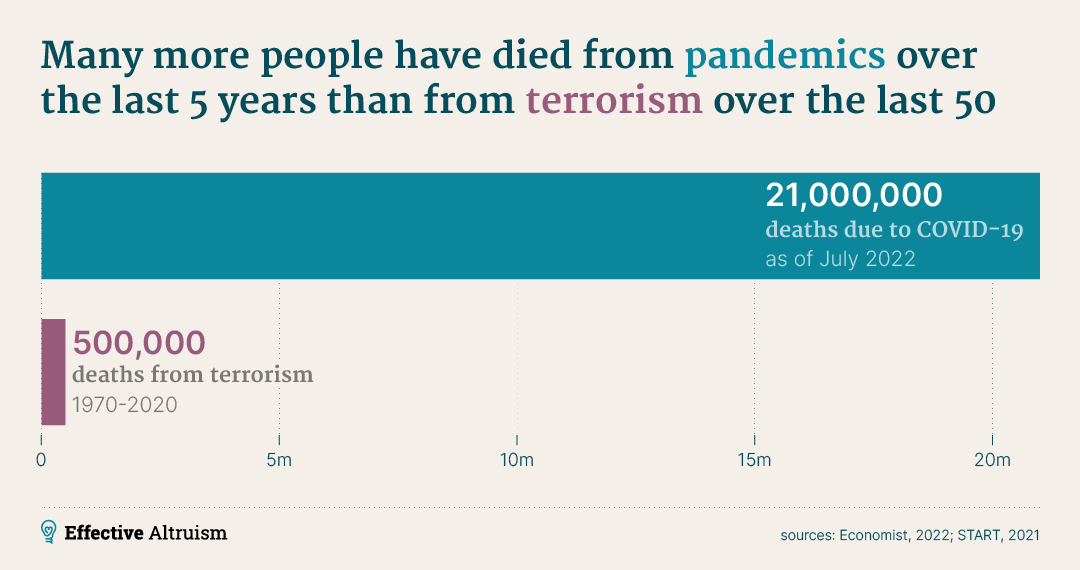
Not to mention, a future pandemic could easily be much worse than COVID-19: there’s nothing to rule out a disease that’s more infectious than the Omicron variant, but that’s as deadly as smallpox. (See more on the comparison in footnote 4.)
In effective altruism, once a big and neglected problem has been identified, the community then looks for solutions that have a chance of making a big contribution to solving the problem, and are neglected by others working on that issue, which brings us to...
Some examples of what’s been done
In 2016 Open Philanthropy – a foundation inspired by effective altruism – became the largest funder of the Johns Hopkins Center for Health Security, which is one of the few groups doing research to identify better policy responses to pandemics, and was an important group in the response to COVID-19.6
When COVID-19 broke out, members of the community founded 1DaySooner, a non-profit that advocates for human challenge trials. In this type of vaccine trial, healthy volunteers are deliberately infected with the disease, enabling near-instant testing of the vaccine. As one of the only advocates for this intervention, 1DaySooner has signed up over 30,000 volunteers,7 and played an important role in starting the world’s first COVID-19 human challenge trial. This model can be repeated when we face the next pandemic.
Members of the effective altruism community helped to create the Apollo Programme for Biodefense, a multibillion dollar policy proposal designed to prevent the next pandemic.
Providing basic medical supplies in poor countries
Why this issue?
It’s common to say that charity begins at home, but in effective altruism, charity begins where we can help the most. And this often means focusing on the people who are most neglected by the current system – which is often those who are more distant from us.
Over 700 million people live on less than $1.90 per day.8
In contrast, an American living near the poverty line lives on 20 times as much, and the average American college graduate lives on about 107 times as much. This places them in the top 1.3% of income, globally speaking.9 (These amounts are already adjusted for the fact that money goes further in poor countries.)
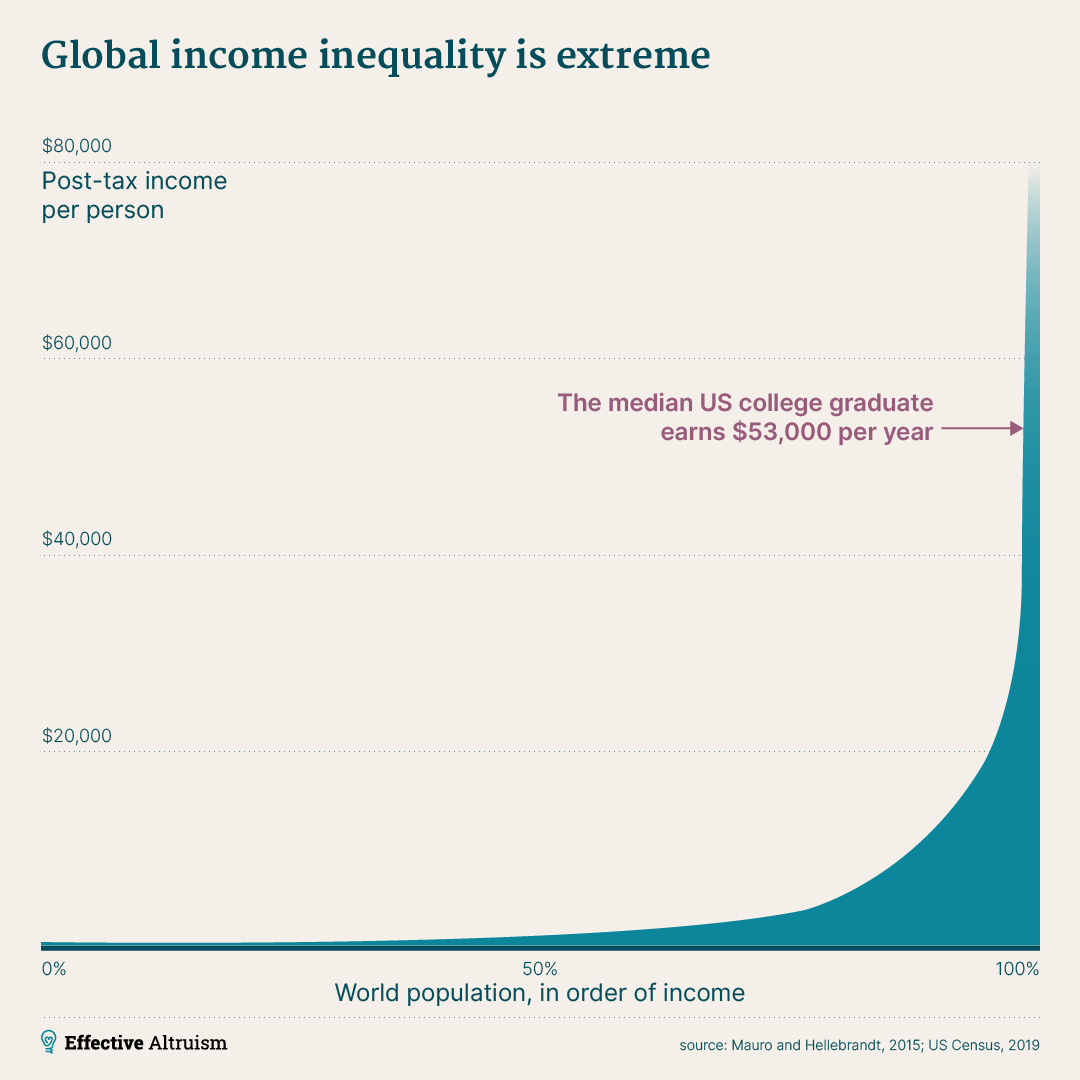
Global inequality is extreme. Because of this, transferring resources to the very poorest people in the world can do a huge amount of good. In richer countries like the US and UK, governments are typically willing to spend over $1 million to save a life.10 This is well worth doing, but in the world’s poorest countries, the cost of saving a life is far lower.
GiveWell is an organization that does in-depth research to find the most evidence-backed and cost-effective health and development projects. It discovered that while many aid interventions don’t work, some, like providing insecticide-treated bednets, can save a child’s life for about $5,500 on average. That's 180 times less.11
These basic medical interventions are so cheap and effective that even the most prominent aid sceptics agree they’re worthwhile.
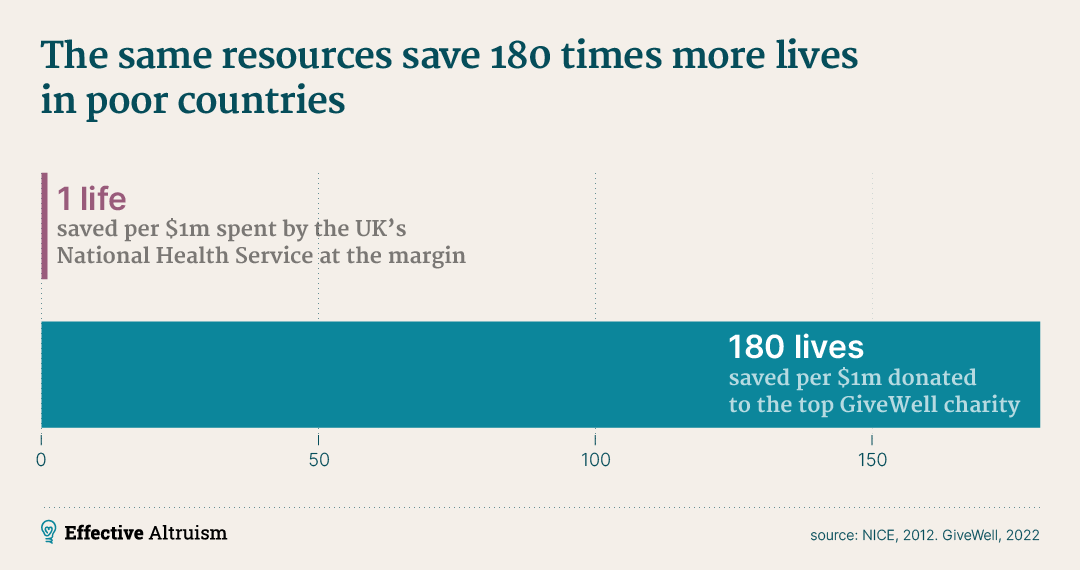
Some examples of what’s been done
Over 110,000 individual donors have used GiveWell’s research to contribute more than $1 billion to its recommended charities, supporting organisations like the Against Malaria Foundation, which has distributed over 200 million insecticide-treated bednets. Collectively these efforts are estimated to have saved 159,000 lives.12
In addition to charity, it’s possible to help the world’s poorest people through business. Wave is a technology company founded by members of the effective altruism community, which allows people to transfer money to several African countries faster and several times more cheaply than existing services. It’s especially helpful for migrants sending money home to their families, and has been used by over 800,000 people in countries like Kenya, Uganda and Senegal. In Senegal alone, Wave has saved its users hundreds of millions of dollars in transfer fees – around 1% of the country’s GDP.13
Helping to create the field of AI alignment research
Why this issue?
People in effective altruism often end up focusing on issues that seem counterintuitive, obscure or exaggerated. But this is because it’s more impactful to work on the issues that are neglected by others (all else equal), and these issues are (almost by definition) going to be unconventional ones. One example is the AI alignment problem.
Artificial intelligence (AI) is progressing rapidly. The leading AI systems are now able to engage in limited conversation, solve college-level maths problems, explain jokes, generate extremely realistic images from text, and do basic coding.14 None of this was possible just ten years ago.
The ultimate goal of the leading AI labs is to develop AI that is as good as, or better than, human beings on all tasks. It’s extremely hard to predict the future of technology, but various arguments and expert surveys suggest that this achievement is more likely than not this century. And according to standard economic models, once general AI can perform at human level, technological progress could dramatically accelerate.
The result would be an enormous transformation, perhaps of a significance similar to or greater than the industrial revolution in the 1800s. If handled well, this transformation could bring about abundance and prosperity for everyone. If handled poorly, it could result in an extreme concentration of power in the hands of a tiny elite.
In the worst case, we could lose control of the AI systems themselves. Unable to govern beings with capabilities far greater than our own, we would find ourselves with as little control over our future as chimpanzees have control over theirs.
This means this issue could not only have a dramatic impact on the present generation, but also on all future generations. This makes it especially pressing from a “longtermist” perspective, a school of thinking which holds that improving the long-term future is a key moral priority of our time.
How to ensure AI systems continue to further human values, even as they become equal (or superior) to humans in their capabilities, is called the AI alignment problem, and solving it requires advances in computer science.
Despite its potentially historic importance, only a couple of hundred researchers work on this problem, compared to tens of thousands working to make AI systems more powerful.15

It’s hard to sum up the case for the issue in a few paragraphs, so if you’d like to explore more, we’d recommend starting here, here and here.
Some examples of what’s been done
One priority is to simply tell more people about the issue. The book Superintelligence was published in 2014, making the case for the importance of AI alignment, and became a New York Times best-seller.
Another priority is to build a research field focused on this problem. For instance, AI pioneer Stuart Russell, and others inspired by effective altruism, founded The Center for Human-Compatible AI at UC Berkeley. This research institute aims to develop a new paradigm of AI development, in which the act of furthering human values is central.
Others have helped to start teams focused on AI alignment at major AI labs such as DeepMind and OpenAI, and outline research agendas for AI alignment, in works such as Concrete Problems in AI Safety.
Ending factory farming
Why this issue?
People in effective altruism try to extend their circle of concern – not only to those living in distant countries or future generations, but also to non-human animals.
Nearly 10 billion animals live and die in factory farms in the US every year16 – often unable to physically turn around their entire lives, or castrated without anaesthetic.
Lots of people agree we shouldn’t make animals suffer needlessly, but most of this attention goes towards pet shelters. In the US, about 1,400 times more animals pass through factory farms than pet shelters.17
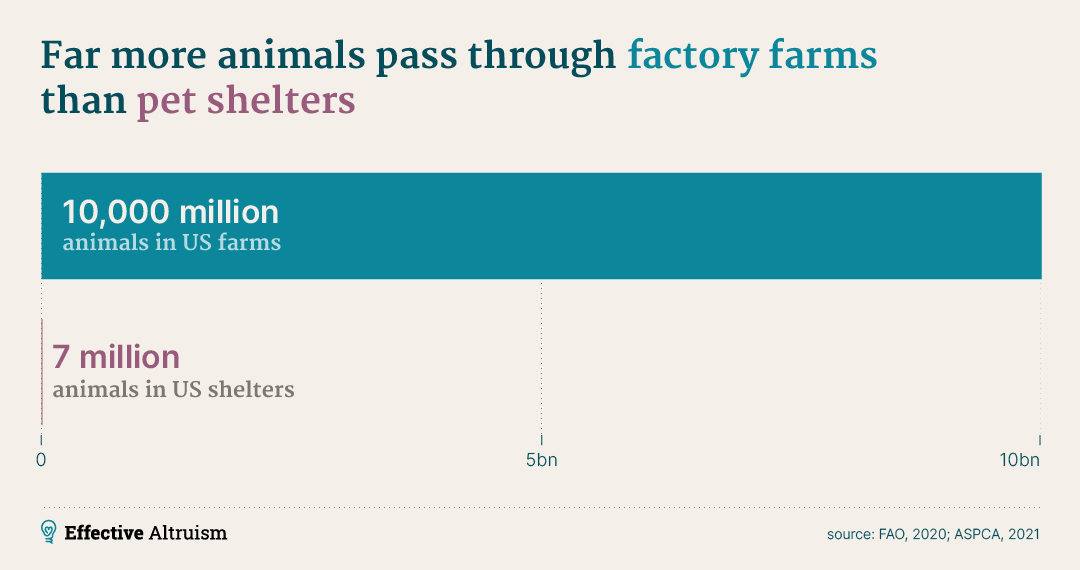
Despite this, pet shelters receive around $5 billion per year in the US, compared to only $97 million on advocacy to end factory farming.18
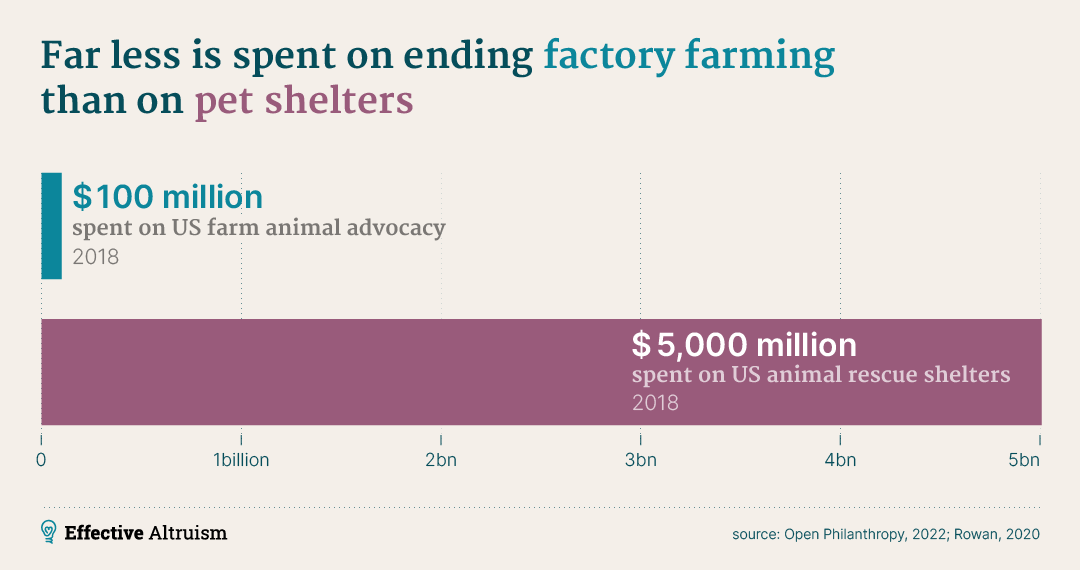
Some examples of what’s been done
One strategy is advocacy. The Open Wing Alliance, which received significant funding from funders inspired by effective altruism, developed a campaign to encourage large companies to commit to stop buying eggs from caged chickens. To date, they have won over 2,200 commitments, and as a result over 100 million birds have been spared from cages.19
Another strategy is to create alternative proteins, which if made cheaper and tastier than factory farmed meat, could make demand disappear, ending factory farming. The Good Food Institute is working to kick-start this industry, helping to create companies like Dao Foods in China and Good Catch in the US, encouraging big business to enter the industry (including JBS, the world’s largest meat company) and securing tens of millions of dollars of government support.20
Open Philanthropy was an early investor in Impossible Foods, which created the Impossible Burger – an entirely vegan burger that tastes much more like meat, and is now sold in Burger King.
Improving decision-making
Why this issue?
People who want to do good often prefer to directly tackle problems, since it’s more motivating to see the tangible effects of their actions. But what matters is that the world gets better, not that you do it with your own two hands. So people applying effective altruism often try to help indirectly, by empowering others.
One example of this is by improving decision-making. Namely: if key actors — such as politicians, private and third sector leaders, or grantmakers at funding bodies — were generally better at making decisions, society would be in a better position to deal with a whole range of future global problems, whatever they turn out to be.
So, if we can find new, neglected ways to improve the decision-making of important actors, that could be a route to having a big impact. And it seems like there are some promising solutions that could achieve this.
Some examples of what’s been done
Many global problems are exacerbated by a lack of trustworthy information. Metaculus is a forecasting technology platform that identifies important questions (such as the chance of Russia invading Ukraine), aggregates forecasts made by hundreds of forecasters, and weighs them by their past accuracy. Metaculus gave a probability of a Russian invasion of Ukraine of 47% by mid January 2022, and 80% shortly before the invasion on the 24th of February21 – a time when many pundits, journalists and experts were saying it definitely wouldn’t happen.
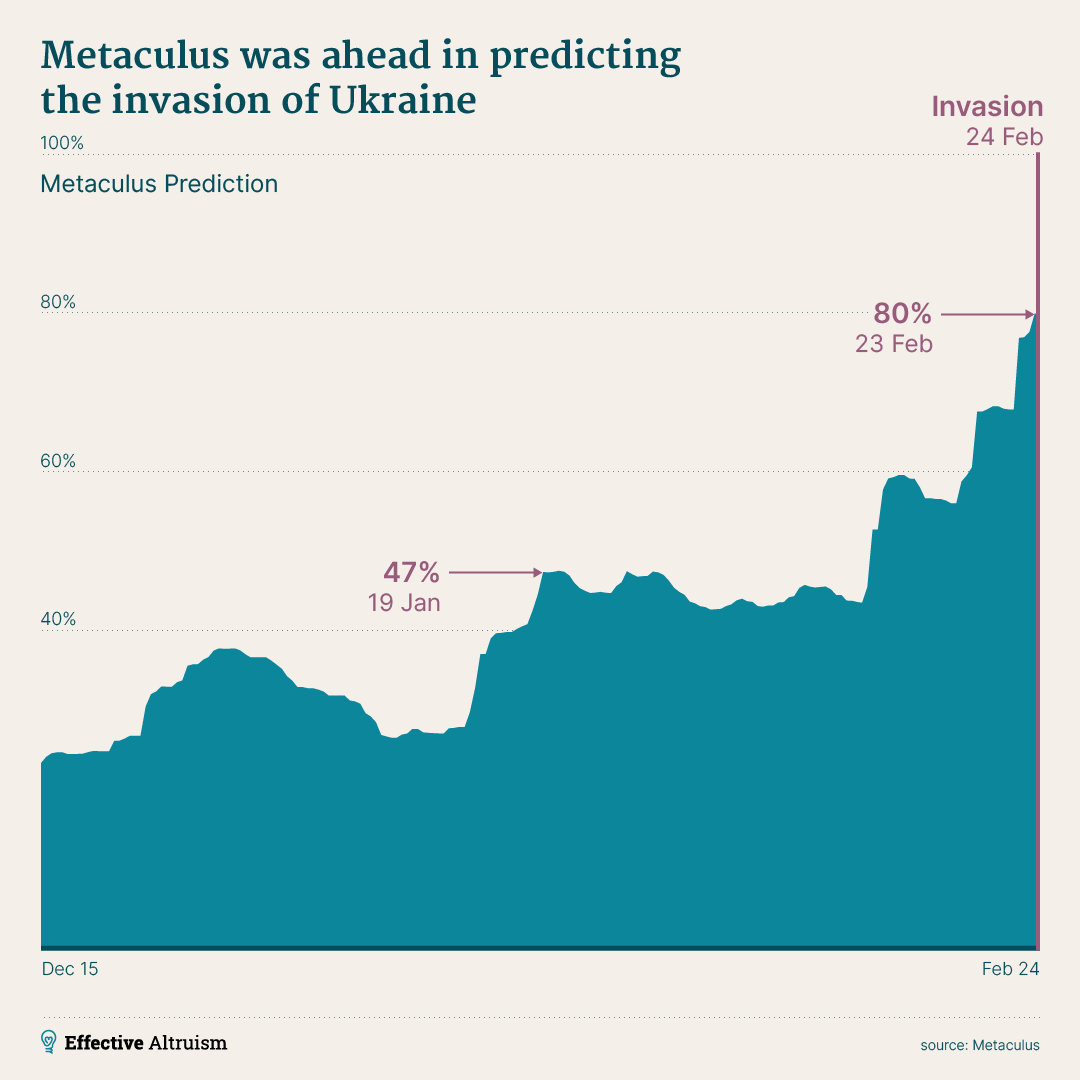
The Global Priorities Institute at the University of Oxford does foundational research at the intersection of philosophy and economics into how key decision-makers can identify the world’s most pressing problems. It has helped to create a new academic field of global priorities research, creating a research agenda, publishing tens of papers, and helping to inspire relevant research at Harvard, NYU, UT Austin, Yale, Princeton and elsewhere.
What values unite effective altruism?
Effective altruism isn't defined by the projects above, and what it focuses on could easily change. What defines effective altruism are some tentative values and principles that underpin its search for the best ways of helping others:
-
Prioritization: Our intuitions about doing good don't usually take into account the scale of the outcomes — helping 100 people often makes us feel as satisfied as helping 1000. But since some ways of doing good also achieve dramatically more than others, it’s vital to attempt to use numbers to roughly weigh how much different actions help. The goal is to find the best ways to help, rather than just working to make any difference at all.
-
Impartial altruism: It's easy — and reasonable — to have special concern for one's own family, friends or nation. But, when trying to do as much good as possible, it seems that we should give everyone's interests equal weight, no matter where or when they live. This means focusing on the groups who are most neglected, which usually means focusing on those who don’t have as much power to protect their own interests.
-
Open truthseeking: Rather than starting with a commitment to a certain cause, community or approach, it’s important to consider many different ways to help and seek to find the best ones. This means putting serious time into deliberation and reflection on one’s beliefs, being constantly open and curious for new evidence and arguments, and being ready to change one’s views quite radically.
-
Collaborative spirit: It’s often possible to achieve more by working together, and doing this effectively requires high standards of honesty, integrity, and compassion. Effective altruism does not mean supporting ‘ends justify the means’ reasoning, but rather is about being a good citizen, while working toward a better world.
We’re not totally confident in the above ideas - but we think that they are probably right, and that they are undervalued by much of society. Anyone who is trying to find better ways to help others is participating in effective altruism. This is true no matter how much time or money they want to give, or which issue they choose to focus on.
Effective altruism can be compared to the scientific method. Science is the use of evidence and reason in search of truth – even if the results are unintuitive or run counter to tradition. Effective altruism is the use of evidence and reason in search of the best ways of doing good.
The scientific method is based on simple ideas (e.g. that you should test your beliefs) but it leads to a radically different picture of the world (e.g. quantum mechanics). Likewise, effective altruism is based on simple ideas – that we should treat people equally and it’s better to help more people than fewer – but it leads to an unconventional and ever-evolving picture of doing good.
How can you take action?
People interested in effective altruism most often attempt to apply the ideas in their lives by:
-
Choosing careers that help tackle pressing problems, or by finding ways to use their existing skills to contribute to these problems, such as by using advice from 80,000 Hours.
-
Donating to carefully chosen charities, such as by using research from GiveWell or Giving What We Can.
-
Starting new organizations that help to tackle pressing problems.
-
Helping to build communities tackling pressing problems.
See a longer list of ways to take action.
The above are not exhaustive. You can apply effective altruism no matter how much you want to focus on doing good, and in any area of your life – what matters is that, no matter how much you want to contribute, your efforts are driven by the four values above, and you try to make your efforts as effective as possible.
Typically, this involves trying to identify big and neglected global problems, the most effective solutions to those problems, and ways you can contribute to those solutions – with whatever time or money you’re willing to give.
By doing this and thinking carefully, you might find it’s possible to have far more impact with those resources. It really is possible to save hundreds of people’s lives over your career. And by teaming up with others in the community, you can play a role in tackling some of the most important issues civilization faces today.
-
You can see the global distribution of local EA groups on the Effective Altruism Forum, which lists groups in over 70 countries.↩
-
The less neglected an issue, the more the best opportunities will have been taken, so the harder it will be for an additional person to make an impact.
In fact, there are good reasons to expect that returns to investment in an issue are roughly logarithmic.
Logarithmic returns imply that if 10 times more has been invested in one cause compared to another, then additional resources will achieve about 1/10 as much progress.
If the two issues are equally important, and then an additional person working on the more neglected one will have ten times the impact.↩
-
From 2010 to 2019, US Federal Funding for Health Security is estimated at $141 billion. We judge that 55% of this was spent on what could arguably prevent future pandemics. For example, 4% was spent tackling the ongoing ebola epidemic, which provided infrastructure for potential other pandemics. However, 17% was spent on chemical and nuclear radiation threats in a way unlikely to affect future pandemic spread.
141 billion * 0.55 = 79 billion
Annualized over the ten year period is $8 billion per year.
Federal funding for health security in FY2019 Watson, Crystal, et al., Health security 16.5 (2018): pages 281-303. Archived link, accessed 5 March 2020.
Open Philanthropy also identifies other foundations and philanthropists working on the topic prior to the COVID pandemic, which we believe total under $100 million in funding.
Crawford, director of the Costs of War project, calculates US spending on Counter-Terrorism from 2001-2022 to be $5.8 trillion.
5.8 trillion / 20 years = $290 billion per year.
United States budgetary costs of Post-9/11 wars Crawford, Neta C., Watson Institute for International & Public Affairs, Brown University, 2021. Archived link, accessed 26 July 2022.↩
-
Deaths from terrorism from 1970-2020 were approximately 456,000. This is from the Global Terrorism Database 2020, accessed 11 August 2022.
Note that Our World in Data says "The Global Terrorism Database is the most comprehensive dataset on terrorist attacks available and recent data is complete. However, we expect, based on our analysis, that longer-term data is incomplete (with the exception of the US and Europe). We therefore do not recommend this dataset for the inference of long-term trends in the prevalence of terrorism globally."
This means the source above is likely an undercount of confirmed terrorism deaths; however, even if we assume deaths have been at the same level as the highest recorded decade (2010-2020) since 1970, the total deathtoll would still only be 1.2 million; far less than deaths due to pandemics.
Deaths from COVID-19:
The Economist estimated cumulative excess deaths due to COVID-19 were 21.47m as of June 2022, and this amount is still rising.
You can see this data and their model through Our World in Data (archived page, retrieved 28 July 2022).
We see this as the best current estimate of COVID-19’s total death toll. The number of confirmed deaths is lower, at around 6 million, but this excludes deaths that were indirectly caused or weren’t reported. The Economist’s methodology compares excess deaths to the seasonal average, to estimate in total how many additional people died, and adjusts for underreporting.
Deaths due to pandemics and terrorism are both heavy tailed, so past death rates will typically understimate the magnitude of the risk.
For instance, it’s possible that terrorists could set off a nuclear weapon in a large city, which might kill over 1 million people. This didn’t happen over the last fifty years, but would have been the main driver of the death toll if it had. And likewise, there could have been a pandemic much worse than COVID-19 or HIV/AIDS in the last 50 years.
The key question then becomes whether the historical record is a greater undercount of the risk for terrorism or for pandemics (i.e. whether terrorism deaths are more heavily-tailed than pandemic deaths).
It seems plausible that the worst case scenario from pandemics is worse than for terrorism. There’s nothing to rule out the emergence of a pandemic that’s more infectious than COVID-19, but with a fatality rate of 10-50%, or worse. And there seem to be more near-misses in the historical record.
So, the problem of missing tail events in the sample may well be worse for pandemics than terrorism. Indeed, the most plausible way for terrorism to kill 1+ billion people is probably via causing a pandemic.
Given that terrorism receives ~100x more funding than pandemic prevention, while pandemics seem to have caused 10-100x more deaths historically, the corrections would need to be very heavily in favour of terrorism in order for the current allocation of resources to seem more balanced.
The above analysis was just in terms of the number of deaths, since that’s an important yet relatively measurable metric. Deaths due to both pandemics and terrorism also produce important indirect costs, and a fuller comparison would attempt to consider the relative scale of each.↩
-
“40.1 million [33.6 million–48.6million] people have died from AIDS-related illnesses since the start of the epidemic.”
Global HIV & AIDS statistics — Fact sheet UNAIDS, 2022. Archived link, accessed 11 August 2022.↩
-
Open Philanthropy is a foundation inspired by effective altruism. They first funded the Johns Hopkins Centre for Health Security (CHS) in 2016. This was followed by several other large grants, including one for $16m in 2017 and another for $19.5m in 2019.↩
-
38,659 volunteers, as of 7 July 2022. 1Day Sooner↩
-
Before COVID-19, the number of people living on less that $1.90 per day had decreased to 689 million in 2017. However, estimates now point to the first rise in the extreme poverty rate since 1998, leading to an estimated 731 million people now living on less than $1.90 per day.
UN SDG 1 - End poverty in all its forms. UN Statistics, 2022. Archived link, accessed 26 July 2022.
These estimates have been adjusted for the fact that money goes further in poor countries (purchasing parity). There are many complications to the estimates, but it’s clear that hundreds of millions of people live at near subsidence levels of income. See “how accurately does anyone know the global distribution of income?” if you’d like to learn more.↩
-
The US poverty line for 1 person is an annual income of $13,590.
13,590 / 365 = $37.23 per day.
This is 20x the international poverty line of $1.90, which is adjusted for purchasing parity.
According to the 2019 census, full-time workers aged 25-65 with a college degree or higher earned a median of $74,000 per year.
$74,000 / 365 = $202.7 per day
$202 / 1.9 = 107x.
According to SmartAsset, a single person household earning $74,000 pre-tax and living in New York, receives about $53,000 post-tax.
According to Giving What We Can’s calculator, a post-tax income of $53,000 puts you in the top 1.3% of income globally.↩
-
The UK’s National Institute for Health and Care Excellence recommends spending up to £30,000 per quality-adjusted life year (QALY) gained, where the intervention is reliable.
“Above a most plausible ICER of £30,000 per QALY gained, advisory bodies will need to make an increasingly stronger case for supporting the intervention as an effective use of NHS resources” Methods for the development of NICE public health guidance. UK National Institute for Health and Care Excellence, September 2012. Archived link, accessed July 28, 2022.
It’s typical in global health to say that saving one life is equivalent to 30 QALYs. Source: World Bank (Box 1.1)
This amounts to a cost of saving a life of 30 x £30,000 = £900,000 = $1.1 million.
In the US, different global agencies estimate “the value of life”, and use this figure in the prioritization of different spending projects. The Federal Emergency Management Agency estimated the value of life at $7.5 million in 2020. This estimate has fluctuated based on the context. For example, the US Department of Transport estimated the value of life to be between $5.2 million and $13.0 million in 2014.↩
-
GiveWell's estimates of the cost to save a life have varied over time (depending on their research, and which opportunities are available), but have typically fallen within $2,500 to $7,500. In 2021, GiveWell estimated that $5500 spent on distributing insecticide-treated bednets will save one life in expectation.
You can see their most up-to-date estimates in their full cost-effectiveness analysis: How We Produce Impact Estimates GiveWell, July 2022. Archived link, accessed 28 July 2022.↩
-
“More than 110,000 donors have trusted GiveWell to direct their donations. Together, they have given over $1 billion to the organizations we recommend. These donations will save over 150,000 lives and provide cash grants of over $175 million to the global poor.”
About GiveWell, GiveWell, July 2022. Archived link, accessed 28 July 2022.↩
-
“When Wave launched in Senegal, our average transfer would have cost 3-5x more if done via the largest existing mobile money system. Multiplied by our millions of monthly active users, that comes out to a savings of over $200 million every year, … around 1% of Senegal’s GDP.”
Working at Wave is an extremely effective way to improve the world. Ben Kuhn, July 8 2021. Archived link, accessed 26 July 2022.↩
-
Conversation: "Our best end-to-end trained Meena model achieves a… SSA [Sensibleness and Specificity Average] score of 72%... our SSA score of 72% is not far from the 86% SSA achieved by the average person.” Towards a Conversational Agent that Can Chat About…Anything. Adiwardana et. al., Google, 28 January 2020. Archived link, accessed 28 July 2022.
Math: The graphs in the attached article show Google’s Minerva accurately answers over 50% of “high school math competition-level problems”. Other state-of-the-art models were achieving less than 10% accuracy.
Minerva: Solving Quantitative Reasoning Problems with Language Models. Dyer et. al, Google, 30 June 2022. Archived link, accessed 28 July 2022.
Jokes: Google’s AI PaLM can provide explanations for jokes never seen before, including jokes nowhere on the internet. For example:
“Joke: Did you see that Google just hired an eloquent whale for their TPU team? It showed them how to communicate between two different pods!
Explanation: TPUs are a type of computer chip that Google uses for deep learning. A ‘pod’ is a group of TPUs. a ‘pod’ is also a group of whales. The joke is that the whale is able to communicate between two groups of whales, but the speaker is pretending that the whale is able to communicate between two groups of TPUs”
Pathways Language Model (PaLM): Scaling to 540 Billion Parameters for Breakthrough Performance. Narang et. al., Google, 4 April 2022. Archived link
Images: Example images from OpenAI’s Dall-E 2 can be seen here.
Coding: Section 3.1 in Salesforce’s ‘A Conversational Paradigm for Program Synthesis‘ research paper about CodeGen, their AI tool turning human instructions into code, outlines that CodeGen achieves a 75% HumanEval score, meaning it can solve 75% of the programming challenges described with normal human language in the HumanEval set.↩
-
It’s difficult to estimate the number of researchers focused on a certain topic since it’s hard to define the topic in the first place, many researchers work on multiple topics, and it’s hard to know the bar for ‘being a researcher’. So these numbers should be understood as estimates to within a factor of three or so, and they could be out by an order of magnitude depending on some interpretations of the question.
In 2020, 87,000 authors published AI research on arXiv. The 2020 Global AI Talent Report from Element AI estimates there are even more people than this working on AI development globally, with 155,000 people labelled on social media as working in AI research or engineering. However we expect some working in AI engineering to not be working on engineering new advancements in AI. We have taken the smaller estimate of 87,000 and roughly halved it for an estimate of 40,000.
In 2021, Gavin Leech estimated that 270 to 830 FTE people worked on AI Safety. However, the upper end of the range of this estimate is based on what we think is an overly broad notion of what constitutes research into AI alignment, and much of the sum was driven by adding up time from lots of researchers spending a small fraction of their time on safety research; while our aim is to quantify the number of researchers focused on AI safety.
AI Watch attempted a headcount of AI Safety researchers, which found 160 notable researchers who have worked on AI Safety. This includes many people who have not published on AI safety in over a year, whereas for the estimate of 87,000 above, all had published in the last year. On the other hand, the bar for being a ‘notable’ researcher might be higher than publishing in arXiv.
Our final estimate is 300 researchers focused on AI safety.↩
-
In 2018, 9.56 billion farm animals were slaughtered for meat in the US. This number has likely risen since then. This includes 9.16 billion chickens; 237 million turkey; 125 million pigs; 34 million cattle and 2 million sheep. Source: visualization at Our World in Data, using data from the UN Food and Agriculture Organization.↩
-
In 2021, approximately 6.5 million animals passed through animal shelters in the US. In 2011, this number was 7.2 million. Assuming a steady decline, this means in 2018 there were approximately 6.7 million animals passing through animal shelters.
9.56 billion / 6.7 million = 1427 times as many animals in factory farms.
Pet Statistics. American Society for the Prevention of Cruelty to Animals, 2021. Archived link, accessed August 2021.↩
-
Animal shelter spending:
Andrew Rowan calculated $5 billion of funding to the top 3000 animal shelter organizations in the US in 2018, published in his paper “Cat Demographics & Impact on Wildlife in the USA, the UK, Australia and New Zealand: Facts and Values” Rowan et. al. (2020), Journal of Applied Animal Ethics Research, pages 7–37.
Andrew Rowan confirmed the data behind these calculations in correspondence with us.
Farm animal advocacy funding:
Research from Open Philanthropy published here finds the following funding for farm animal advocacy groups in 2018:
- $32.3 million for Established US groups (PETA, PCRM, HSUS, ALDF, ASPCA)
- $32.6 million for new, major US-based groups (CIWF, WAP, RSPCA, HSI)
- $32.2 million for all other US groups
32.3 + 32.6 + 32.2 = $97.1 million↩
-
106.5 million hens are now in cage-free housing in the US alone as of May 2022, as reported by the USDA Egg Markets Overview, compared to 17 million in 2016. We believe another 100 million have become cage-free in Europe as a result of Open Wing Alliance’s work, although this number is harder to attribute to them specifically.
In addition, advocates have now secured corporate pledges that, if implemented, should cover more than 500 million hens alive at any time.↩
-
After engagement with GFI, the US government announced a $10 million grant to create a center of excellence in cellular agriculture at Tufts University. The UK’s independent National Food Strategy recommended a £125 million investment in alternative protein research and innovation. Source: GFI Year in Review 2021 (page 3)↩

Impartial altruism is a radical concept. I'm sure it would be among the most debated idea?
What brought me here was discovering GiveWell their approach to finding the most cost-effective interventions really resonated with me, and I've already started giving based on their research. It's incredible that some interventions can be 100x or even 1,000x more effective than others.
I'm also working to transition into AI alignment research as a career. The fact that only a few hundred researchers work on alignment compared to tens of thousands making AI more powerful really highlights how neglected this problem is. I'm hoping this program will help me think more clearly about how I can contribute to this field.
Factory farming is another area I'm passionate about the scale of suffering and how underfunded advocacy is compared to its impact potential is striking.
Looking forward to learning from everyone and challenging my assumptions along the way!
Very good introduction to effective altruism. However, I was thinking about the example of the spending on counter terrorism and pandemics prevention. The low number of deaths by terrorism could be due to the large spending on counter terrorism so if we allocate such spending in pandemic prevention the number of terrorism victims could increase. How to know how much resources to re-allocate for optimal distribution?
This is a good introduction. Hopefully we'll delve more into things like-
1. Breadth v/s depth- teaching alphabets to 10K kids v/s making 500 kids well educated enough to earn a livelihood thru their education and to think critically.
2. The "WHY" of some assumptions- e.g., why is it really necessary to think of humanity surviving beyond a century- and the scope for people to hold differing views on these
3. Comparing across causes- is saving the life of a 60 year old more important than preventing a 16 year old girl from being trafficked for prostitution?
4. Broadening ideas like "helping better decision making" to include ideas like promoting philanthropy to create MORE resources. The current thinking seems to assume that EA is operating in a zero sum game, which may not be the case, and one could argue that "promoting giving" can be even more effective.
Thanks, this is a comprehensive introduction of Effective Altruism.
Nice and enriched introduction, as a new to field of effective altruism, I can say now I have a lot to say about the concept and movement
The two causes that have really caught my eye are the AI alignment problem and improving decision making. I'd never fully realized just how interesting and impactful these issues are.
I love what I am exposing myself to via Effective Altruism Rwanda.
I find it really interesting to read about efforts to improve decision-making through data analysis and knowledge comparison. It might seem obvious to some, but in practice, people in positions of power often rely on experts rather than engaging with the data themselves. There are always countless variables that complicate decision-making, but I’d love to learn more about how this process works—and especially how trust can be built to encourage its wider use.
I agree that helping the largest number of people in need on a particular issue is important. I think we also need to consider both the resources we have available to us and the area of geography that we are needing to align with. Our Foundation is restricted to a specific geography based on government direction and historical relationships. Within this geography there may be more need is certain areas than others, but either there are others that are helping to meet this need in that area while there are few helping to meet this need in a area of lower population. So we look to fill gaps where we think we can have an impact even if the numbers helped are lower.
Great article, and easy to understand. I believe more emphasis should be placed on not just ending factory farming, but on strengthening non human animal rights. Furthermore, apart from the cruelty involved in animal agriculture, it is a major contributor to climate crisis and future pandemics.
When we serve others, we often do so in expectation of personal benefit... The senses of connectedness, worth, well-being, and so on, that can arise. Not to mention the visceral appreciation of others' lives by serving them individually. Personal service to others is vital and worthy. Please do not minimize it.
A key value to consider in all efforts is their sustainability. An effort that does not nourish the altruist should not continue. Merely emphasizing maximum instantaneous benefit to the recipient does not maximize long term benefit of the needs of the altruist are not also part of the equation.
I'm grateful for some related content in the FAQ referenced here. But I believe if you're going to examine our whole system of altruism, you need to view the servant as part of that system.
I commend to you the book Standing at the Edge by Joan Halifax for lots more about sustainable service.
Fascinating introduction. The statement that "charity begins where we can help the most" is particularly interesting.
"For instance, some charities help 100 or even 1,000 times as many people as others, when given the same amount of resources"
Someone told me that an EA org is about to publish an article saying this isn't true.
See also Why Charities Usually Don't Differ Astronomically in Expected Cost-Effectiveness, mentioned in Criticisms of the use of cost-effectiveness estimates, at the end of Chapter 2
More efforts should be put into ending factory farming, it's a big contributor to climate change other than animal suffering.
I fully agree with this! It's also key to solving many different issues - animal suffering, climate change, and nutrition-related illnesses
That is such an interesting light to shine on this perspective. It really sends home the drive to serve as an advocate to end animal farming.
I think this is exceptionally well-written, compelling and informative. Fantastic job!
This is an engaging intro to effective altruism. The statement "The goal is finding the best way to help, rather than just working to make any difference at all" really grabbed my attention.
I feel like poverty or low quality-of-life should be in the list of examples.
for anyone who hasn't checked out the 80000hours site, it's incredibly insightful and practically helpful for everyone passionate about EA https://80000hours.org/career-reviews/founder-impactful-organisations/#lists-of-ideas
The article highlights the proactive approach of identifying significant yet overlooked global challenges and seeking optimal solutions, while tailoring contributions to match personal resources. This thoughtful approach can yield substantial impacts, potentially saving numerous lives throughout one's career.
Furthermore, the article encourages collaboration within the community to collectively address critical contemporary challenges. By uniting efforts, individuals can actively participate in tackling some of society's most pressing issues, thus playing a pivotal role in shaping a better future. Overall, this article resonates as an inspiring call to action for effecting meaningful change through purposeful and strategic altruism.